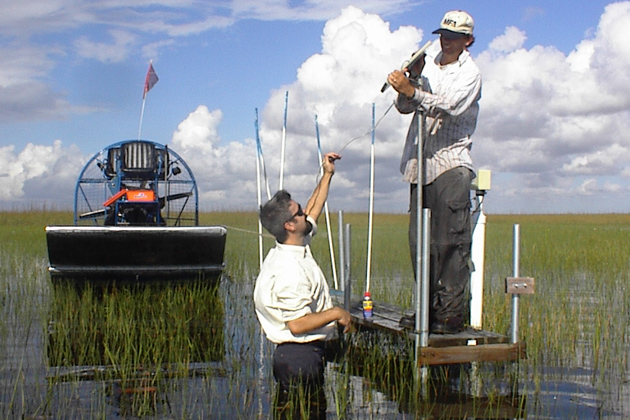A semi-permanent high pressure weather pattern, commonly known as the Bermuda High, shifted to the southeast about 2,800 years ago. As a consequence, tropical storms that had routinely hit South Florida were shunted into the Gulf of Mexico. The resulting change in weather pattern was an important precursor of current environmental conditions in the Florida Everglades.
In an article published this month in the Proceedings of the National Academy of Sciences (PNAS), John Volin, professor and head of the Department of Natural Resources and the Environment in the College of Agriculture and Natural Resources, and his colleagues, write that this climate shift decreased deposits of wind-blown dust that had previously been carried into the Everglades from as far away as the Sahara Desert in North Africa. This circumstance significantly altered the region’s hydrology, nutrient supply, and vegetation.

Volin and his colleagues did a multi-proxy analysis of a sediment core from the Northeast Shark River Slough located in Everglades National Park. Their results indicate that prior to about 2,800 years ago, a wet climate with high dust loadings prevailed in the region. That dust was a key nutrient source for the development of large peatlands that covered the area now known as the Everglades. “The result of this wind shift is a drier climate that supports the saw grasses and tree islands dominating the region,” Volin says.
This knowledge is important, he adds, because it means that current conditions in the Everglades may not reflect the ecosystem’s previous drivers. The implications are significant:
“Our findings give us a window on what can happen in a time of abrupt climate change,” Volin explains, “and we can view this as a model of how natural fluctuations in the climate – not to mention those that are influenced by humans – can alter the landscape. Basically, the Everglades went from a marshland to what it looks like today – with tree islands and ridges interspersed with free flowing channels of water, called sloughs.”
Saving the Everglades
The research is also part of a comprehensive effort to preserve, or in some cases restore, the environmental integrity of this important subtropical region of South Florida. Covering approximately four million acres in an area that begins near Orlando where the Kissimmee River discharges into Lake Okeechobee, and extending 100 miles southward to Florida Bay, the Everglades are protected by what Volin terms, “a mosaic of efforts” under the umbrella of the Comprehensive Everglades Restoration Plan.
If we lose the Everglades and the ecosystem it represents, we’ll never get it back. Studies like this one give us a chance to get it right.
He says that following World War II, the Central and South Florida Canal Project of 1948 authorized draining parts of the Everglades to make room for agricultural development. Dams and levees were constructed for flood control, and water was diverted to provide for the needs of the two million people who lived in that part of the state.
“By the year 2000, the population in southeast Florida had grown to 5 million, with ever-increasing demands on the water system,” he notes. “The Everglades had been compartmentalized by more than 1,000 miles of canals and levees designed for flood control. About 700,000 acres had been claimed to grow sugar cane and other crops and that resulted in the dumping of damaging nutrients into the natural system. Basically, the Everglades were in danger of collapsing.”
However, President Bill Clinton, during one of his last acts in office, authorized the ‘Water Resource Development Act of 2000,’ which committed a multibillion dollar budget to comprehensive Everglades restoration. Out of this came $7.8 billion for funding the Comprehensive Everglades Restoration Plan, a plan developed by the U.S. Army Corps of Engineers to restore the South Florida ecosystem, including the Everglades.

Volin says the plan provides a blueprint for what has been described as the world’s largest ecosystem restoration effort. It includes restoring natural flows of water, water quality, and more natural hydro-periods within the remaining natural areas.
“I can honestly say that this is an amazing collaboration,” Volin says, “because it has successfully brought together state and federal governmental entities, scientists, and concerned citizens. In fact, one of the most interesting aspects of the legislation that created [the Comprehensive Everglades Restoration Plan ] is that the U.S. Congress mandated that any decisions made had to be governed by sound science and be subject to scientific review.”
Volin’s interest in restoration ecology has made him a vocal advocate for the Everglades. Prior to coming to UConn in 2007, he was professor and director of the environmental sciences program at Florida Atlantic University. While in Florida, he was a member of the Science Coordination Group of the Comprehensive Everglades Restoration Plan, the Research Committee Chair for the Florida Exotic Pest Plant Council, and a member of the Greater Everglades Wetlands Module Group.
Referring to the results of the study reported in PNAS, Volin says, “As efforts continue to save the Everglades, it is research such as this that helps guide us. If we could step back in time and restore the Everglades to the way it was 2,800 years ago, we’d be looking at one scenario. As it is, we have to look at current climate conditions and needs driven by today’s population dynamics. What we hope to do is put back the natural drivers as much as possible, and allow the system to evolve and develop into a healthy, dynamic environment.
“If we lose the Everglades and the ecosystem it represents, we’ll never get it back,” he adds. “Studies like this one give us a chance to get it right.”



